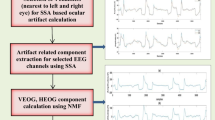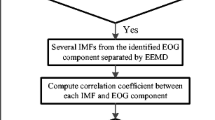Abstract
Frequent occurrence of ocular artifacts leads to serious problems in interpreting and analyzing the electroencephalogram (EEG). In the present paper, a novel and robust technique is proposed to eliminate ocular artifacts from EEG signals in real time. Independent Component Analysis (ICA) is used to decompose EEG signals. The features of topography and power spectral density of those components are extracted. Moreover, we introduce manifold learning algorithm, a recently popular dimensionality reduction technique, to reduce the dimensionality of initial features, and then those new features are fed to a classifier to identify ocular artifacts components. A k-nearest neighbor classifier is adopted to classify components because classification results show that manifold learning with the nearest neighbor algorithm works best. Finally, the artifact removal method proposed here is evaluated by the comparisons of EEG data before and after artifact removal. The results indicate that the method proposed could remove ocular artifacts effectively from EEG signals with little distortion of the underlying brain signals and be satisfied the real-time application.





Similar content being viewed by others
References
Cayton L (2005) Algorithm for manifold learning. University of California, San Diego, Technical Report CS2008–0923
Chiang L, Russell E, Braatz R (2000) Fault diagnosis in chemical processes using Fisher discriminant analysis, discriminant partial least squares, and principal component analysis. chemom Intell Lab Syst 50:2243–2252
Cox TF, Cox MAA (2000) Multidimensional scaling, 2nd edn. Chapman and Hall, London
Delorme A, Makeig S (2004) EEGLAB: an open source toolbox for analysis of single-trial EEG dynamics including independent component analysis. J Neurosci Methods 134:9–21
Delorme A, Sejnowski T, Makeig S (2007) Enhanced detection of artifacts in EEG data using higher-order statistics and independent component analysis. Neuroimage 34(4):1443–1449
Escudero J, Hornero R, Abásolo D, Fernández A, Coronado ML (2007) Artifact removal in magnetoencephalogram background activity with independent component analysis. IEEE Trans Biomed Eng 54:1965–1973
Halder S, Bensch M et al (2007) Online artifact removal for brain-computer interfaces using support vector machines and blind source separation. Comput Intell Neurosci 2007:1155–1165
Hoffmann S, Falkenstein M (2008) The correction of eye blink artifacts in the EEG: a comparison of two prominent methods. PLoS One 3(8):e3004.108
Hyvärinen A, Oja E (2000) Independent component analysis: algorithms and applications. Neural Netw 13:411–430
Jollife IT (2002) Principal component analysis. Springer Press, New York
Joyce CA, Gorodnitsky IF, Kutas M (2004) Automatic removal of eye movement and blink artifacts from EEG data using blind component separation. Psychophysiology 41:313–325
Jung T-P, Humphries C, Lee T-W, Makeig S, McKeown MJ, Iragui V et al (1998) Extended ICA removes artifacts from electroencephalographic recordings. Adv Neural Inf Process Syst 10:894–900
Jung T-P, Makeig S, Humphries C, Lee T-W, McKeown MJ, Iragui V, Sejnowski TJ (2000) Removing electroencephalographic artifacts by blind source separation. Psychophysiology 37:163–178
Jung T-P, Makeig S, Westerfield M, Townsend J, Courchesne E, Sejnowski TJ (2000) Removal of eye activity artifacts from visual event-related potentials in normal and clinical subjects. Clin Neurophysiol 111:1745–1758
Lee T-W, Bell AJ, Sejnowski TJ (2000) A unifying information-theoretic framework for independent component analysis. Comput Math Appl 39:1–21
Making S, Bell AJ, Jung T-P, Sejnowski TJ (1996) Independent component analysis of electroencephalgraphic data. Advance in neural information processing systems 8, MIT press, Cambridge MA 145–151
Mardia KV, Kent JT, Bibby JM (1979) Multivariate analysis. Academic Press, London
Nayar SK, Nene SA, Murase H (1995) Subspace methods for robot vision. Technical Report CUCS-06-95, Columbia University, New York
Pless R (2003) Using isomap to explore video sequences. In proceedings of international conference on computer vision
Schlogl A, Keinrath C, Zimmermann D et al (2007) A fully automated correction method of EOG artifacts in EEG recordings. Clin Neurophysiol 118:98–104
Seung HS, Daniel DL (2000) The manifold ways of perception. Science 290:2268–2269
Tenenbaum JB, DeSilva V, Langford JC (2000) A global geometric framework for nonlinear dimensionality reduction. Science 290:2319–2323
Vigario R, Särelä J, Jousmäki V, Hämäläinen M, Oja E (2000) Independent component approach to the analysis of EEG and MEG recordings. IEEE Trans Biomed Eng 47:589–593
Viola FC, Thorne J, Edmonds B, Schneider T, Eichele T, Debener S (2009) Semi-automatic identification of independent components representing EEG artifact. Clin Neurophysiol 120(5):868–877
Acknowledgments
The work is supported by National Nature Science Foundation of China (grants No. 30870654 and No. 60963012).
Author information
Authors and Affiliations
Corresponding authors
Rights and permissions
About this article
Cite this article
Gao, J., Lin, P., Yang, Y. et al. Real-time removal of ocular artifacts from EEG based on independent component analysis and manifold learning. Neural Comput & Applic 19, 1217–1226 (2010). https://doi.org/10.1007/s00521-010-0370-z
Received:
Accepted:
Published:
Issue Date:
DOI: https://doi.org/10.1007/s00521-010-0370-z




